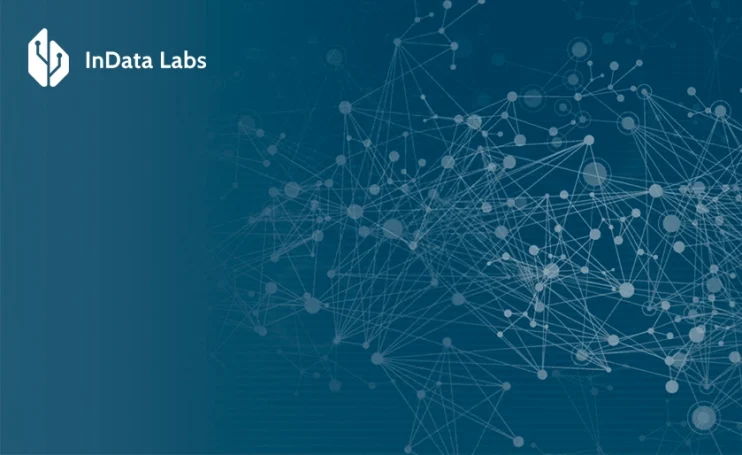Business decisions should never be made based on instincts alone. LLM for data analytics is an ally for companies that operate in the information-buzz era. Thanks to this process enhanced with AI, they can always make informed choices based on facts, statistics, and insights. Since the volume and complexity of datasets continue to skyrocket, organizations want to introduce innovative solutions to extract meaningful information from numerous sources.
In this article, we will explain how large language models became a game-changer in this area, revolutionizing the way businesses process data and extract actionable intelligence.
Data analysis explained
Data analytics is the term that describes the process of examining vast datasets to discover patterns, tendencies, correlations, and other valuable information hidden inside them. The main purpose of this science is to present certain trends and verities about the world and support businesses or individuals in making better decisions.
Since humanity produces approximately 328.77 million terabytes daily, it’s crucial to collect, prepare, analyze, visualize, and interpret data to determine the most interesting and relevant bits. The development of the internet accelerated this field, and the rise of artificial intelligence sped it up even more. The ability to use data analytics effectively will be crucial for businesses to thrive in the digital age.

Source: Unsplash
By leveraging statistical techniques, mathematical methodologies, and all types of algorithms (including machine learning and deep learning), organizations can learn about the effectiveness of their actions, monitor customer satisfaction, and understand what drives their revenues.
This way, companies can become empowered to curate more people-oriented solutions, become leaders in their field, and quickly react to evolving market dynamics. Moreover, data analytics provides knowledge that helps reduce the negative impact of certain activities and eliminate risks while improving operational efficiency and increasing productivity. Overall, it’s a necessary tool for brands that want to offer personalization on an exceptional level, grow their audience, drive profit, and improve internal affairs.
Components of data analytics process
What strategies do data analysts follow to achieve expected goals? Here are the key components of the process:
- Data collection: Gathering information from relevant sources is the first phase. Places where valuable data can be found include external and company-owned databases, spreadsheets, IoT devices, social media, online news portals, other types of media coverage, and so much more. Data is usually classified as structured, semi-structured, or unstructured, and comes in different formats such as text, numbers, images, audio, and video.
- Data preparation: To achieve the most consistent and high-quality results, it’s required to clean and organize collected data. Then, it has to be transformed into a form suitable for the upcoming steps. At this point, duplicates are removed, missing values are handled, and all data formats are standardized.
- Data analysis: Now, the data analytics specialists incorporate the most suitable methods to perform the analysis. For example, they can use descriptive methods to summarize the traits of data or diagnostic frameworks to identify similarities and anomalies. Predictive analytics are great for forecasting, and prescriptive analytics are used to recommend data-driven approaches.
- Data visualization: Presenting results in a digestible way is crucial in the whole process. That’s why analysts prepare visual presentations with charts, graphs, dashboards, and conclusions. Stakeholders can understand better why some things happen and what direction to follow next.
- Data interpretation: Finally, all the insights gained during data analysis should be embedded within the context of the business objectives and needs. Analysts must communicate their findings clearly and concisely, highlighting key takeaways and recommendations that can inform strategic decision-making.
Understanding large language models (LLMs)
For years, people analyzed data manually. Experts were digging through tons of information, looking for patterns or interesting divergences. The invention of the computer was the first step towards faster work and automation. AI development became a true game-changer. Especially large language models proved to be particularly useful in the field.

The invention of LLMs (including ChatGPT large language model) represents a significant milestone in AI advancement. They can be used in versatile tasks, including but not limited to data analytics, and adapted to specific requirements whenever the project evolves. Processing data with large language models proves to be particularly useful for businesses seeking to extract insights from textual datasets at scale.
How to build an LLM for data analytics
Large language model development involves several phases. Each of them is essential to achieve optimal performance and the ability to understand real-world scenarios that are presented within the data.
Data acquisition and preprocessing
LLM analytics tools should be fed with the largest possible amounts of data of exceptional quality. This levels up their learning process. Texts can be extracted from diverse sources like media outlets, books, blog posts, websites, and social media channels.
When the collection of various information sets is ready, it goes through preprocessing that includes cleaning, tokenization, and formatting. This last step is quite important because the text has to be suitable for training the model.
Model training
To train the large language model, powerful computing resources are required. Sophisticated algorithms use various techniques like self-attention mechanisms or transformer architectures to capture long-range dependencies and semantic relationships within the text.
Fine-tuning
Training is not enough to achieve extraordinary results – that’s why fine-tuning is performed. Additional data that is relevant to the goals of the data analysis process is provided to enhance LLM’s capabilities for a specific task. Thanks to this stage, businesses can adjust the model to their unique objectives and needs. Usually, thanks to fine-tuning, they can set a direction for the project and decide if the LLM should focus on sentiment analysis, text summarization, translation, or something else.
Deployment
When the large language model is ready and aligned with assumed goals, it can be integrated into the data analytics workflow. This phase involves the implementation of LLM into the existing infrastructure, ensuring compatibility with data sources used by the company. The LLM data science partner responsible for preparing the model itself also has to establish protocols for testing, updates, and maintenance. It’s recommended to continuously monitor and evaluate the performance of the model to establish if it meets the expectations and detect areas for refinement. This way, businesses can maintain efficiency over time.
Business applications of LLMs in data analytics
Large language models’ use cases showcase how versatile data analytics LLMs can be. The wide range of examples where they can be incorporated includes:
LLM sentiment analysis
LLM data analytics is exceptional when it comes to understanding the context and sentiment of textual data. That’s why businesses can utilize them for customer feedback analysis and brand reputation monitoring. This way, organizations can gain valuable insights that will help them respond better to new customer preferences and emerging market trends. Additionally, thanks to LLM for sentiment analysis, they can design brand perception better and react to potential reputational hiccups at speed.

Source: Unsplash
Customer support automation
Companies that want to bet on support systems for building closer relationships with their customers should take advantage of large language models’ capabilities to understand unorganized texts. They can analyze relationships between various sources and detect customer reactions or emotions based on their inquiries. AI chatbots that answer questions and email systems for automated support are perfect examples of data analysis that can be used to improve customer satisfaction. AI-powered models are also great when it comes to personalized assistance.
Text generation and summarization
Content generation and document summarizing were never as easy. With the help of LLMs, employees can generate human-like messages which helps them quickly reply to emails, stay on track with marketing strategies, and be consistent in communication. Automated report writing and the ability to condense complex files into more comprehensible pieces of information also speed up daily work and free time for more creative and strategic tasks.
Predictive analytics
Being aware of past patterns means the ability to predict future trends, anticipate customer behaviors, and be one step ahead of the competition.

Market Intelligence
Large language model data analytics can be used as intel in the information-loaded digital world of news, industry reports, social media entries, and other data sources. The competitive analysis becomes more insightful and less time-consuming with models that are trained to monitor the market, the biggest industry players, and consumer preferences. Information extracted from these activities can be used to make most business growth-related decisions.
Fraud detection and risk management
By analyzing textual data such as transaction records, applications, inquiries, customer messages, and online interactions, LLMs can assist in detecting fraudulent activities and successfully mitigate potential dangers. Their data analysis skills prove to be useful in detecting suspicious patterns and flagging risks in real time, leading to minimized financial losses and improved security.

Source: Unsplash
Multi-language translations
Companies with global aspirations can save tons of time thanks to LLM for analytics. They can translate location-specific content and support communication with international audiences. All that in less time than professional translators. Of course, for legal purposes, it’s important to work with specialists. Still, for day-to-day usage, well-trained models can serve with their translation abilities to expand reach, improve cross-cultural endeavors, and enhance user experience in products destined for multiple markets.
Advantages of large language models for data analytics
Data analytics workflows powered with LLMs offer several benefits that should not be overlooked. What are the main pros of using them?
- Scalability: LLMs take data analytics to the next level by providing the ability to process large datasets rapidly. Organizations that want to harness big data efficiently should invest in such solutions to maximize results.
- Accuracy: Precision offered by large language models comes from advanced deep learning algorithms. They can achieve spectacular effects while keeping the highest level of performance. This allows companies to confidently use the extracted insights.
- Cost-efficiency: Compared to traditional data analysis methodologies, LLMs prove to be less budget-consuming in the long run. The initial investment into model preparations and training can be higher, but it can automate repetitive tasks later on, reducing the need for manual intervention and streamlining the process.
- Adaptability: Large language models’ applications can be adjusted to concrete business domains, which makes them universal to a variety of industries and requirements. They can help solve various challenges no matter what type of business they are integrated with and what kind of task they are asked to perform.
- Real-time insights: The ability to quickly react to new market dynamics is crucial in today’s world. Ordinary data processing can’t compare to the LLM-powered analytics in that area. Companies that bet on them can make faster decisions and shorten time-to-market when responding to emerging customer demands.
- Innovation: Organizations can differentiate themselves within their respective niches by using LLMs in their data analytics efforts. This gives them a competitive edge when developing products and services, optimizing internal processes, or discovering trend-driven opportunities.
Ethical considerations for using LLMs in data analytics
Like with all AI-driven solutions, LLMs are also discussed in terms of ethics and potential dangers they could be responsible for not only in data analytics but in general. To understand these considerations and how to address them, it’s important to dive deeper into the complexities and potential implications of using large language models for business.
One of the main problems mentioned by skeptics is data security and privacy. LLM for data analytics is trained on vast datasets, which often contain sensitive information. Unauthorized access, safety breaches, and misuse of data are listed to be the most burning challenges to address. Brands must implement robust security measures to ensure data protection. These can include but are not limited to sophisticated encryption, access control, anonymization methodologies, and compliance with legal requirements.

Source: Unsplash
Another critical issue to keep in mind is potential bias in training data, which can lead to discriminatory outcomes. LLMs that are not trained with caution can perpetuate existing gender, racial, or socioeconomic biases, prolonging the negative impact on marginalized groups. Businesses should avoid that risk by carefully evaluating their training data and implementing fairness-aware algorithms. Conducting regular audits and tweaking the models, so they can produce unbiased results, is also necessary.
Last but not least, there’s a question of transparency. Should institutions that use AI in data analytics be open about it to keep their accountability? Many adversaries mention the “black box” dilemma, which implies that we’re not entirely sure how artificial intelligence models make decisions and produce results. That’s why a lack of honesty can undermine trust among customers.
Organizations should inform that LLM analytics is a part of their process and prepare documentation on architectures, training frameworks, and the usage of insights provided by AI. This way they can always explain the hows and whys of their internal workflows to consumers, stakeholders, auditors, and legal entities. Additionally, this helps them avoid or eliminate potential risks.
Conclusion
The amount of data in today’s digitized and globalized world, as well as its complicated structures, requires the implementation of modern solutions. Large language models revolutionized the data analytics sector, helping brands achieve their goals thanks to the processing and drawing conclusions from large amounts of textual data. Businesses that want to skyrocket their decision-making and grow should definitely consider investing in LLM data analytics.



